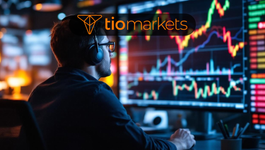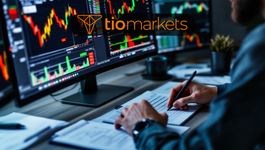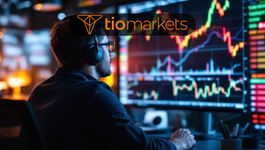The Best Amount to Start Trading With
BY Chris Andreou
|dezembro 13, 2021Your trading account has been created; you have received that confirmation email from your broker. You’re all excited and your mind is racing about what markets you should trade in first. But then it hits you, “What is the best amount to start trading with?”
It depends! Before we can answer what the best amount to start trading with is, you need to consider many things. Such as skill level, financial means, style of trading, what to trade and the objectives too. That is to name just a few.
When starting out, most people have no idea what the best amount to start trading with is. You might have heard that you need $10,000 or $1,000 and then see adverts to start from as little as $50. The truth is that all of those amounts can be correct, since the answer depends on many different variables.
In this one, I will explain how much you need to start trading with and what the best amount to start trading with is, all in my own opinion of course.
So without any further delay, let’s dive straight in.
The right amount to start trading with is more than you think
The correct amount to start trading with is an amount of money you can afford to lose. The best amount to start trading with is something relatively small, to allow yourself the time to learn. Afterwards, you can trade more confidently with larger amounts.
The profit potential might not seem like much as you start considering smaller amounts, but that is not the objective yet. Even though you do need to risk more money to gain a larger profit potential, your first objective is to learn how to trade and manage risk.
Figure out what you want to trade
There are many aspects of trading that you have to deal with, such as analysis, execution of trades and the correlations between markets. You also need to know what factors affect the prices.
What you choose to trade will have a direct effect on how fast you can potentially make or lose money. So if you want to start trading volatile instruments with $50 and without doing your homework, you can.
But be aware that the risk of loss can also increase when starting to trade with very small amounts. Risky trading is not only reserved for those people who want to start with large amount.
Ideally, you should have a bigger cushion to trade in the most volatile instruments.
Figure out your risk tolerance
More importantly, you should take the time to learn how to manage risk. While many people think that risky trading is done with large amounts. It can just as easily be done with small amounts, by beginners who don’t yet know what they are doing.
The best amount to start trading with isn’t the only question here. The real issue is how much money you can afford to lose on any trade idea. Answering that question will help you to determine what the best starting amount is.
So how much money should you risk? The short answer is: as little as possible and no more than what you are comfortable with.
It varies from person to person, but there is consensus in the trading community.
As a general rule of thumb, you should risk a small percentage (1%) of your account on any single trade idea. So, if you have $10,000 in your account, risk about $100 per trade. If you have $1,000 in your account, risk about $10 per trade.
If you start with the minimum, which is $50, then things get slightly more complicated.
Because risking 50 cents per trade and trading with the minimum volume, would mean that your stop loss would be too close. Your style of trading is going to be restricted.
You need to be realistic when deciding on how much to risk and consider your trading objectives too. Don’t choose an amount that you cannot afford to lose. On the other hand, don’t choose such a small amount where the probability of losing increases because it is too restrictive!
The best way to determine your risk tolerance is to ask yourself this question: If I lose this, will it bother me much? The answer is that it shouldn’t, and you should be comfortable with losing that even during a losing streak.
Are you still not sure what that amount is? The best way to test your risk tolerance is to start trading and experience it for yourself.
The best amount to start trading with
Alternatively, follow these steps to help you figure it out.
1. Check the assets volatility
Start by make a list of the assets or markets you want to trade in, and then make a note of the level of volatility in each of them. Volatility is defined as how much a currency pair, stock or indices’ price can move. It is one of the most important factors to consider before choosing your trade size.
2. Have clear goals for your trading
Secondly, the best amount of money you need to start trading is going to depend on the type of trading you want to do. Position trading, swing trading, day trading and scalping are different styles that require different approaches to risk management. It’s wise to have more money, and a larger cushion against adverse price movements.
More money will probably be required trading with the former styles, compared to the latter ones.
3. Check the broker’s contract specification
Third, the minimum amount to open trades varies from broker to broker. You should check the contracts specification for margin requirements and the price of the asset you want to trade. This will let you know how much you need as margin to open and maintain trades.
4. Weigh up the risk vs the potential reward
At the same time, it’s important that you make trading worth it — if you’re putting in hours to try to profit a couple of dollars per day, you might start to think this isn’t feasible. It’s important to strike a decent balance between risk and potential rewards with the amount you will be starting with. Choose an amount that makes sense, allows you to learn and enjoy the process while still being excited about the opportunity.
Remember that your primary objective is to learn and develop good trading habits. This involves understanding and managing risk.
Have proper risk management in place
Many people want to start trading with little to no money at all and that is simply not realistic. You need real experience and longevity to learn, which involves taking losses and understanding how the markets work.
So, having proper risk management in place is necessary. How much money you start trading with will determine whether you can have a realistic chance of doing that.
How much money do you need to start trading?
The best amount of money to start trading with depends on things mentioned above.
However, I have pondered this question many times and if you are pressing for my opinion, the amount I came up with was $1,000 in your trading account. My answer is general in nature and aimed at the beginner; because I don’t know people’s individual financial situations.
$1,000 is a good amount to start trading with because you’ll be able risk $10 (1%) and lose 100 times in a row, before your money is gone. That is unlikely to happen if you follow the general 1% rule of thumb, so in reality you will probably get more trades than that.
This is not a lot by most people’s standards, especially for a business venture. It may be enough to provide some longevity to buy you some time to learn.
With that being said, there are still a lot of people who just aren’t comfortable risking that amount of money to start trading. So the next best amount is $500, however things can change slightly from here.
Risk has doubled from 1% to 2%, so some longevity might have been sacrificed to keep the amount to risk the same ($10). So that can be recalculated to $5 risk per trade, and sacrifice some of the distance of the stop loss.
In the case of the latter, risk remains at 1% but the probability of loss might increase. Because trading with the minimum would require placing the stop loss closer.
I will elaborate on this a little more, using Forex trading as an example.
Example of trading with a small amount
The average daily price range for currency pairs is about 100 pips. When you choose to trade the minimum volume on the platform, the value per pip will be about 10 cents.
At this point, a 100 pip stop loss will allow you to risk $10 per trade. For short term trading, this can be an adequate margin for error, by some people’s standards to provide room for the trade to breathe.
Taking the same relative risk of $5 on a $500 account would mean halving the distance of the stop loss, and possibly increasing the probability of getting stopped out. Trading with this scenario would require better judgement in timing the market to compensate for the tighter stop loss.
If you’re new to trading, you’ll want to use a trading strategy that’s relatively simple, provides you with a decent margin for error and allows for more time for the trade to develop.
You can tighten the stop loss through experience and optimising your trading strategy. As a beginner, it’s better to give yourself a larger margin for error and focus more on risk management.
Use our profit calculator to see how trading with different lot sizes affects profit (or loss).
Start with an amount of money that you have
There is no right amount to start trading with, just the best amount to start trading with for you. The more you trade, the more experience you’ll get and eventually, the better you’ll become at judging how much to risk on each trade.
There is a common misconception among many traders that they need to have all the money in their trading accounts to start trading. When really you don’t, you just need enough to cover your margin requirements and some equity as risk to cushion your trades.
If you only have a small amount of money to start trading with, you can start with that and then deposit more later on.
Choose a trading account for any budget
You should approach trading as a long term thing, that require study, practice and time.
It’s not so much about the amount to start with, it’s what you end up with that counts. Take your time to learn and practice, it’s what will help you to get better results.
Aim to build your knowledge as well as your trading account slowly in the beginning. You can start trading with something relatively small, to avoid running out of money before you have learnt what to do.
Each trader has different means and goals, decide what you want to trade and what style of trading you want to do. Then work backwards from that to calculate the best amount to start trading with.
First decide how much you are comfortable risking per trade, make that a small percentage of your intended amount. Then multiply that to get an idea of how much you should deposit in your trading account.
You will know what the best amount to start trading with is.
I hope this has provided you with some general guidelines to help in your decision making process.
Start trading with a reputable broker, create a demo or live trading account today and experience it.
Risk disclaimer: CFDs are complex instruments and come with a high risk of losing money rapidly due to leverage. You should consider whether you understand how CFDs work and whether you can afford to take the high risk of losing your money. Never deposit more than you are prepared to lose. Professional client’s losses can exceed their deposit. Please see our risk warning policy and seek independent professional advice if you do not fully understand. This information is not directed or intended for distribution to or use by residents of certain countries/jurisdictions including, but not limited to, USA & OFAC. The Company holds the right to alter the aforementioned list of countries at its own discretion.
Join us on social media

Experienced independent trader
Related Posts





